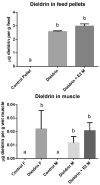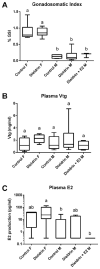Sexually dimorphic transcriptomic responses in the teleostean hypothalamus: a case study with the organochlorine pesticide dieldrin
- PMID: 23041725
- PMCID: PMC3618895
- DOI: 10.1016/j.neuro.2012.09.012
Sexually dimorphic transcriptomic responses in the teleostean hypothalamus: a case study with the organochlorine pesticide dieldrin
Abstract
Organochlorine pesticides (OCPs) such as dieldrin are a persistent class of aquatic pollutants that cause adverse neurological and reproductive effects in vertebrates. In this study, female and male largemouth bass (Micropterus salmoides) (LMB) were exposed to 3mg dieldrin/kg feed in a 2 month feeding exposure (August-October) to (1) determine if the hypothalamic transcript responses to dieldrin were conserved between the sexes; (2) characterize cell signaling cascades underlying dieldrin neurotoxicity; and (3) determine whether or not co-feeding with 17β-estradiol (E(2)), a hormone with neuroprotective roles, mitigates responses in males to dieldrin. Despite also being a weak estrogen, dieldrin treatments did not elicit changes in reproductive endpoints (e.g. gonadosomatic index, vitellogenin, or plasma E(2)). Sub-network (SNEA) and gene set enrichment analysis (GSEA) revealed that neuro-hormone networks, neurotransmitter and nuclear receptor signaling, and the activin signaling network were altered by dieldrin exposure. Most striking was that the majority of cell pathways identified by the gene set enrichment were significantly increased in females while the majority of cell pathways were significantly decreased in males fed dieldrin. These data suggest that (1) there are sexually dimorphic responses in the teleost hypothalamus; (2) neurotransmitter systems are a target of dieldrin at the transcriptomics level; and (3) males co-fed dieldrin and E(2) had the fewest numbers of genes and cell pathways altered in the hypothalamus, suggesting that E(2) may mitigate the effects of dieldrin in the central nervous system.
Copyright © 2012 Elsevier Inc. All rights reserved.
Figures






References
-
- Blocksom KA, Walters DM, Jicha TM, Lazorchak JM, Angradi TR, Bolgrien DW. Persistent organic pollutants in fish tissue in the mid-continental great rivers of the United States. Sci Total Environ. 2010;408:1180–9. - PubMed
-
- Büdefeld T, Tobet SA, Majdic G. Steroidogenic factor 1 and the central nervous system. J Neuroendocrinol. 2012;24:225–35. - PubMed
-
- Czlonkowska A, Ciesielska A, Gromadzka G, Kurkowska-Jastrzebska I. Estrogen and cytokines production – the possible cause of gender differences in neurological diseases. Curr Pharm Des. 2005;11:1017–30. - PubMed
Publication types
MeSH terms
Substances
Grants and funding
LinkOut - more resources
Full Text Sources
Other Literature Sources
Medical

